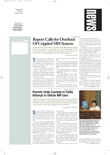A new national report calls for greater federal investment in resources, research, and training to meet the physical, medical, psychological, and social needs of children in the event of terrorism.
The National Advisory Committee on Children and Terrorism (NACCT) presented its report and recommendations to Secretary of Health and Human Services Tommy Thompson in June.
The 13-member committee consisted of experts from fields including psychiatry, public health, education, pediatrics, child development, emergency management, disaster planning, and child advocacy.
The committee recommended that effective disaster planning for children should at a minimum do the following:
• Include pediatric experts such as child mental health specialists in all stages of disaster and terrorism event planning at the federal, state, and local levels.
• Focus on settings where children gather including schools, summer camps, and child-care facilities.
• Coordinate and integrate disaster response plans among federal, state, and local agencies and hospitals, relevant professional and community organizations, and nontraditional “first responders” such as clergy and teachers.
• Emphasize returning children to normal routines with appropriate support services as soon as possible after a disaster to promote family and community resilience.
“The committee has established a helpful and comprehensive framework for preparing and carrying out an action plan for children. We must not overlook their different and special needs as we plan for emergencies of all types,” said Thompson in a press release.
Child psychiatrist and committee consultant Betty Pfefferbaum, M.D., J.D., told Psychiatric News, “The committee is to be commended for paying attention to the psychosocial needs of children from infancy to adolescence before, during, and after disasters or terrorism.”
She is professor and chair of the department of psychiatry and behavioral sciences at the University of Oklahoma Health Sciences Center. She also directs the National Center for Child Traumatic Stress’s Terrorism and Disaster Branch.
As recently as 1997, the Federal Emergency Management Agency indicated that no state disaster plans had pediatric components and that only about 20 percent of hospitals had access to pediatric emergency physicians. In addition, the majority of emergency personnel had little pediatric training or experience, according to committee chair Angela Diaz, M.D., in a June 12 letter to Thompson.
Congress mandated in the Public Health Security and Bioterrorism Preparedness and Response Act of 2002 that Thompson establish an advisory committee to review the health care and emergency medical systems’ capacities to respond to the biopsychosocial needs of children in a terrorist event or disaster, said Pfefferbaum.
The committee was also charged with reviewing and recommending changes to emergency procedures and the Strategic National Stockpile. The stockpile makes available vaccines, antibiotics, and pediatric pharmaceuticals and emergency equipment anywhere in the United States within 12 hours of a federal decision, according to the report.
The federal government has initiated several key projects since September 11, 2001, including creating a new Office of Terrorism Preparedness and Emergency Response within the Centers for Disease Control and Prevention (CDC), which managed and staffed the NACCT, according to the report.
However, “what was missing was a comprehensive public health strategy to meet the needs of children in planning and responding to terrorism,” said Pfefferbaum.
The advisory committee recommended that a focus on children’s needs be required in all relevant HHS programs and that funding be linked to accountability, said Pfefferbaum.
The national committee recommended that the federal government fund and conduct research to identify patterns of trauma experienced by children and interventions that foster their resilience, coping, and recovery from disasters and terrorism.
Research efforts that are already underway to develop reliable measures of children’s emotional distress and psychological factors need continued funding, urged the committee. “Measures of a child’s distress can include a sense of safety, fear, worry, and danger rather than full DSM criteria,” commented Pfefferbaum.
These measures should eventually be integrated into all postdisaster medical evaluations, the committee recommended.
Early intervention is critical following a terrorist event or disaster to prevent problems from developing in the future, the report points out. The committee recommended that a national set of principles and best practices be developed to guide the use of psychological and social interventions in children.
“Primary health care providers, police, firefighters, and emergency medical technicians will need to be trained in these best practices in addition to municipal leaders, teachers and other school personnel, clergy, and family members,” according to the report.
Thompson at press time was evaluating the NACCT recommendations. It is expected that the CDC will coordinate distribution and implementation of the recommendations with other HHS agencies, according to CDC spokesperson Von Roebuck.
The NACCT report is posted on the CDC Web site at www.bt.cdc.gov/children. ▪
